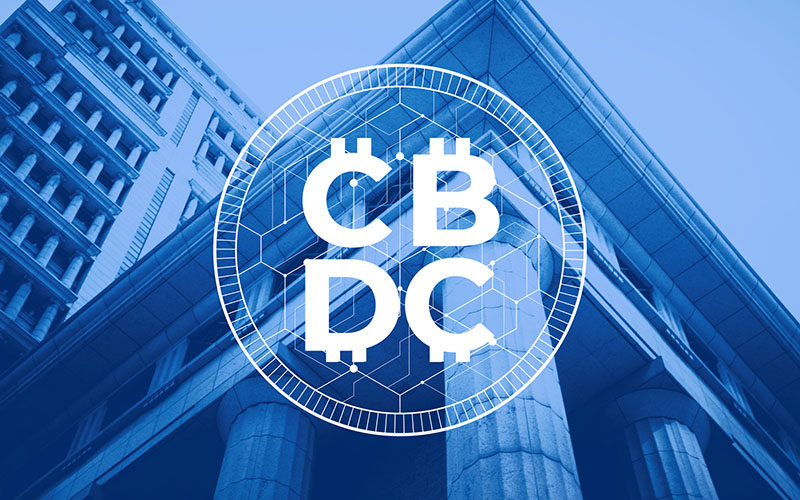In the age of digital innovation and the rise of cryptocurrency trading, the concept of CBDCs has emerged as a hot topic in the financial world.
Page Contents
What are CBDCs?

Central Bank Digital Currencies are digital versions of a country’s fiat currency issued. Cryptocurrencies such as Bitcoin, CBDCs are not decentralized and retain the backing and stability of the respective government.
CBDCs aim to complement physical cash and existing forms of electronic payment, offering a secure and efficient means of conducting transactions in a digital era. The primary goal of CBDCs is to provide a trusted and regulated alternative to private cryptocurrencies while ensuring financial stability, consumer protection, and monetary policy control.
Why Do CBDCs Matter?
Central Bank Digital Currencies (CBDCs) hold significant promise in reshaping the financial landscape for several compelling reasons:
- Financial Inclusion: CBDCs have the power to bring the unbanked and underbanked populations into the formal financial system. By providing a digital alternative to physical cash that requires only a smartphone and internet access, CBDCs can extend financial services to remote and marginalized communities, fostering economic empowerment and reducing inequality.
- Payment Efficiency: The traditional cross-border payment infrastructure is often slow and costly due to multiple intermediaries. CBDCs can streamline this process, enabling near-instantaneous, low-cost international transactions. This can boost global trade and financial inclusion for individuals and businesses alike.
- Monetary Policy Tools: Central banks can leverage CBDCs to enhance their monetary policy toolkit. They can fine-tune money supply, interest rates, and inflation more precisely, responding to economic fluctuations with agility and precision.
- Reduced Counterfeiting: CBDCs come equipped with robust security measures that significantly reduce the risk of counterfeit currency entering circulation. This strengthens trust in the currency and minimizes economic disruptions caused by counterfeiting.
- Financial Stability: During times of crisis, CBDCs can provide a secure digital alternative to physical cash. This can mitigate the risk of bank runs, ensuring that individuals have access to their funds when they need them the most. This financial stability can prevent economic downturns from spiraling out of control.
Different Models of CBDCs

Central banks worldwide are exploring diverse models of Central Bank Digital Currencies (CBDCs), each tailored to specific economic and regulatory contexts. These models include:
- Retail CBDCs: Targeted at the general public, retail CBDCs act as a digital counterpart to physical cash. People can hold and transact with them using digital wallets or apps.
Retail CBDCs promote financial inclusion, offering a secure and accessible form of digital currency for individuals, even those without traditional bank accounts.
- Wholesale CBDCs: Designed for financial institutions, wholesale CBDCs facilitate large-scale interbank transactions and settlement systems. These CBDCs enhance the efficiency of the financial sector, reducing operational complexities and risks in the wholesale banking system.
- Hybrid CBDCs: Combining elements of both retail and wholesale CBDCs, hybrid CBDCs cater to a broader range of users, including individuals, businesses, and financial institutions. They provide a flexible approach that adapts to various economic needs while maintaining a unified digital currency framework.
- Token-Based vs. Account-Based CBDCs: CBDCs can be token-based, functioning similarly to cryptocurrencies, with digital tokens representing value. Alternatively, they can be account-based, with transactions recorded in centralized databases, resembling traditional bank accounts. The choice between these models affects the design and operational characteristics of CBDCs.
Central banks are carefully considering which CBDC model best aligns with their economic objectives and regulatory frameworks. The choice between these models will influence the accessibility, functionality, and impact of CBDCs in their respective jurisdictions.
Consequently, the exploration and development of these CBDC models are critical steps in shaping the future of digital finance.
Advantages of CBDCs

Financial Inclusion
CBDCs have the potential to enhance financial inclusion by providing access to banking services for unbanked and underbanked populations. With a digital currency accessible through smartphones, individuals without traditional bank accounts can participate in the formal financial system, fostering economic growth and reducing income inequality.
Efficiency and Cost-Effectiveness
CBDC transactions can be executed in real-time, 24/7, reducing settlement times and lowering transaction costs compared to traditional banking systems. Eliminating intermediaries streamlines the payment process, benefiting businesses and consumers.
Monetary Policy Implementation
Central banks can leverage CBDCs to implement more effective monetary policies. By having direct control over digital currency, they can influence interest rates, inflation, and currency circulation, leading to more efficient and responsive economic management.
Counteracting Private Cryptocurrencies
The rise of private cryptocurrencies, like Bitcoin, has raised concerns among regulators due to their potential to disrupt financial stability and facilitate illicit activities. CBDCs offer a controlled alternative that could help mitigate risks associated with unregulated digital assets.
Concerns and Challenges

While Central Bank Digital Currencies (CBDCs) hold immense potential, their implementation and widespread adoption come with several complex challenges and considerations:
- Privacy Concerns: CBDCs, by design, can offer a high degree of transparency, potentially allowing central authorities to track individual transactions. Striking the right balance between transparency for regulatory purposes and preserving individual privacy is a significant challenge.
- Cybersecurity: The digital nature of CBDCs makes them susceptible to cyberattacks. Ensuring robust security measures is paramount to prevent hacking, fraud, and unauthorized access to digital wallets.
- Monetary Policy Implications: CBDCs can impact traditional monetary policy tools like interest rates and money supply. Central banks must carefully assess how CBDCs fit within their policy framework to maintain economic stability.
- User Adoption and Experience: Successful CBDC implementation relies on user adoption. Central banks must ensure that CBDCs are user-friendly, accessible, and convenient. This includes addressing issues like digital literacy and ensuring that those without access to smartphones or internet services can still use CBDCs.
- International Cooperation: The cross-border nature of digital currencies raises concerns about interoperability and international cooperation. Harmonizing CBDC systems across different countries and regulatory frameworks is essential to avoid fragmentation of the global financial system.
- Operational Resilience: CBDCs need to be highly reliable and resilient to maintain public trust. This requires robust infrastructure, disaster recovery plans, and safeguards against technical failures or outages.
- Financial Stability: While CBDCs can enhance financial stability during crises, they can also potentially exacerbate systemic risks if not managed properly. Central banks need to carefully plan for worst-case scenarios and establish safeguards.
- Legal and Regulatory Frameworks: Establishing the legal and regulatory framework for CBDCs is a complex task. Governments and central banks must navigate existing financial regulations while adapting to the unique characteristics of digital currencies.
Conclusion
Central Bank Digital Currencies present opportunities and challenges in reshaping the future of money and financial systems. As countries explore the development of CBDCs, the advantages of financial inclusion, efficiency, and monetary policy implementation cannot be overlooked.
The qumas ai app, focusing on Effective Trading, finding trading partners, and privacy protection, stands at the forefront of enabling users to embrace the potential benefits of CBDCs while navigating the intricacies of the ever-changing crypto landscape.
It is important to remember that implementing CBDCs should be a gradual and well-considered process, with careful attention to user education, cybersecurity, and privacy protection.
The collaboration between governments, central banks, and technology providers will be key to unlocking the full potential of CBDCs and driving financial inclusion into the digital future.






